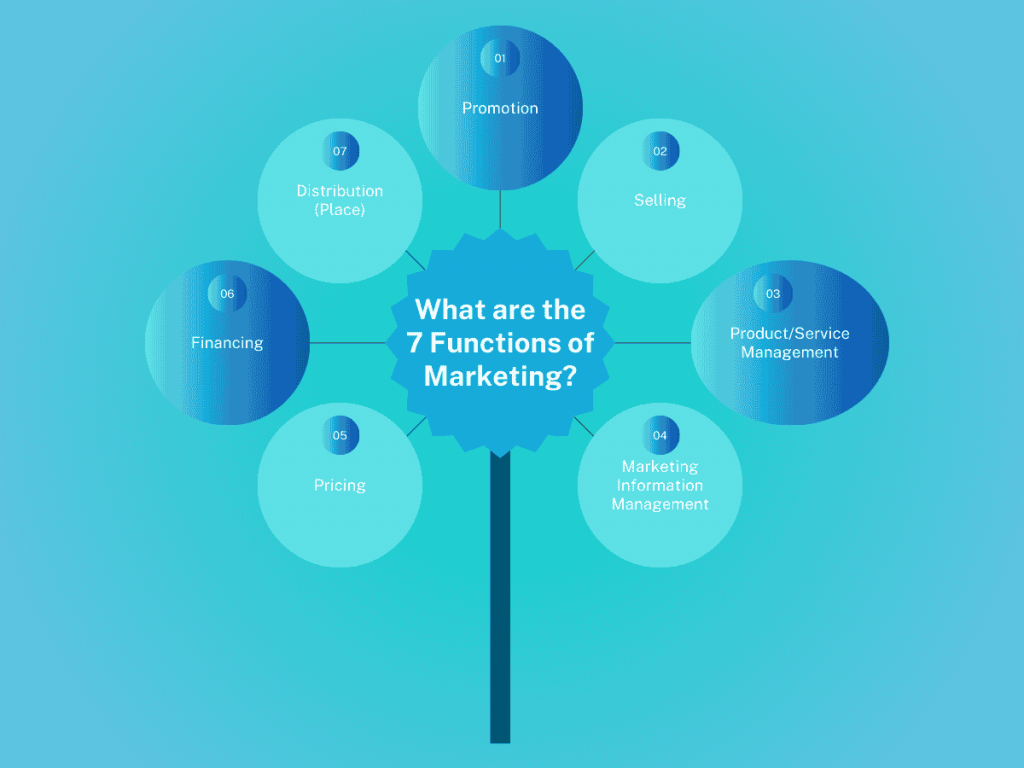Marketing has evolved a lot over the years, but its purpose has always stayed the same. It is all about helping businesses connect with the people who actually need their products or services. Every time you scroll through social media, check prices online, or walk into a store, you are interacting with different functions of marketing even if you do not notice it.
To understand how marketing really works, experts break it down into the seven functions of marketing. These functions guide businesses in understanding their customers, creating meaningful offers, communicating value, and building relationships that last. They may seem simple at first, but they are the foundation of every successful marketing strategy.
In this beginner friendly guide, we will walk through what are the 7 functions of marketing in a clear and easy way.
What are the 7 Functions of Marketing?

The seven functions of marketing are:
- Promotion
- Selling
- Product/Service Management
- Marketing Information Management
- Pricing
- Financing
- Distribution (Place)
Each function plays a unique role, but they all work together to attract, satisfy, and retain customers.
1. Promotion
Promotion is all about how a business communicates with its audience. It goes far beyond simple advertising and focuses on creating awareness, building interest, and encouraging people to take the next step toward choosing your product or service. Effective promotion means understanding what your audience cares about and sharing your message in a way that feels relevant and valuable to them.
Promotion matters because even the best product cannot succeed if people never hear about it. This part of marketing makes sure the right message reaches the right people at the right moment, helping your brand stand out in a busy marketplace.
Promotion can appear in many everyday situations, such as:
- Brands showcasing new products through Instagram or TikTok campaigns.
- A company releasing engaging YouTube videos to introduce something new.
- Email newsletters sharing updates, offers, or upcoming launches.
- Influencers presenting products to their communities.
- Traditional channels like posters, billboards, and radio messages.
Strong promotion is essentially a form of storytelling. It helps people understand why your product matters and gives them a reason to pay attention.
2. Selling
Selling focuses on the direct interaction between a business and its customers. It is the personal side of marketing where conversations, guidance, and support help people make confident buying decisions. Whether it happens face to face, through a phone call, or online, selling ensures customers feel understood and cared for.
This function is essential because even with the rise of automated tools, online checkout pages, and artificial intelligence, people still need human support. They often look for clear explanations, reassurance, and personalized advice before committing to a purchase. Selling helps remove confusion and builds trust throughout the entire buying experience.
Selling appears in many real world situations, such as:
- A store associate helping you choose the most suitable laptop.
- A salesperson demonstrating product features during a live presentation.
- Chat supports guiding customers as they compare different options.
- Car dealerships arrange test drives to help buyers feel confident.
- A software company offering a tailored walkthrough to potential clients.
Selling is not about pressuring someone to make a purchase. It is about understanding their needs and guiding them toward the solution that fits them best.
3. Product/Service Management
Product or service management focuses on creating, refining, and enhancing what a business offers. It is a continuous process shaped by customer expectations, shifting trends, and advancements in technology. This function ensures your business does not fall behind and remains valuable in a constantly changing market.
It matters because customer needs evolve. Trends rise and fade. Technology introduces new possibilities and challenges. A business that ignores these shifts risks becoming outdated. Strong product management helps companies stay aligned with what people truly want and delivers offerings that feel current and competitive.
Product or service management often includes activities such as:
- Understanding customer needs and expectations.
- Improving product quality to enhance satisfaction.
- Introducing new features that add more value.
- Developing completely new products based on market demand.
Real world examples include:
- Apple releases updated iPhone versions each year with improved features.
- Netflix expanding categories, languages, or user tools to improve the viewing experience.
- Clothing brands offering inclusive sizes or using more sustainable fabrics.
- Food companies designing healthier or allergen aware alternatives.
Successful product management is always rooted in customer insight rather than guesswork.
4. Marketing Information Management
Marketing information management involves gathering, organizing, and analyzing data to support better decisions. In a world where analytics shape nearly every aspect of business, this function has become one of the most important parts of modern marketing.
It matters because relying on assumptions can lead to ineffective strategies and wasted resources. Data provides clarity. It helps businesses understand their audience, see what is performing well, predict future behavior, and lower the risk of making poor decisions.
Marketing information management often includes activities such as:
- Studying customer behavior to understand preferences.
- Identifying which strategies or campaigns are successful.
- Tracking patterns to forecast future demand.
- Improving marketing efforts based on real evidence.
- Reducing uncertainty by relying on measurable insights.
Data is the compass that guides every smart marketing strategy.
5. Pricing
Pricing focuses on determining the most suitable amount a customer should pay for a product or service. Although it might appear straightforward, effective pricing requires careful research, thoughtful planning, and a strong understanding of both the market and customer expectations. The goal is to set a price that reflects the value you provide while still supporting the financial goals of the business.
Pricing matters because it influences many important aspects of your brand. It affects profit margins, shapes how customers perceive your product, impacts demand, and helps define your position in the market. A single pricing decision can completely shift how people view your business, which is why an informed approach is essential.
Effective pricing aims to create the right balance between what customers expect and what allows the business to grow profitably.
6. Financing
Financing helps both businesses and customers manage costs, payments, and budgets more effectively. For businesses, it includes securing the funds needed to support marketing activities such as advertising, product development, and staffing. For customers, it focuses on offering payment options that make purchasing easier and more accessible.
Financing matters because marketing efforts cannot move forward without investment. At the same time, customers often appreciate flexible payment choices when considering higher priced items. Good financing practices help maintain steady cash flow and remove financial barriers on both sides of the transaction.
Financing ensures that operations run smoothly while also supporting customer convenience and overall business growth.
7. Distribution (Place)
Distribution focuses on making sure a product is available to customers in the easiest and most efficient way. It covers everything from storage and transportation to delivery and accessibility. Even if a product is high quality, customers will not purchase it if it is difficult to obtain.
Distribution matters because it directly affects how smoothly customers can find and receive your product. Strong distribution leads to higher satisfaction, stronger convenience, and better overall reach. It also helps reduce delivery times and supports consistent availability.
Distribution often includes activities such as:
- Managing storage and inventory so products are always ready.
- Organizing transportation to move products efficiently.
- Ensuring customers can shop through their preferred channels.
- Reducing delivery times for a better experience.
How These 7 Functions of Marketing Work Together?
Each function of marketing has its own role, but they work best when they support each other. Together, they create a smooth customer journey and help a business grow in a more focused and effective way.
It all starts with gathering information to understand customers and market trends. These insights guide product or service development so businesses can create or improve offerings that people actually want.
After that, pricing is set in a way that reflects value and matches customer expectations. Distribution ensures the product is available in the places customers prefer to buy, while financing provides the budgets and payment options needed to support both the business and the buyer. Promotion then brings attention to the product, and selling helps convert that interest into real purchases through personal interaction and support.
When all seven functions work together, businesses attract the right audience, build trust, and grow sustainably. While the “7 functions of marketing” give a broad and operational view of what marketing does, many marketers also refer to the classic Marketing Mix, the 4 Ps: Product, Price, Place, and Promotion.
Final Thoughts
The seven functions of marketing may appear straightforward, but together they form the foundation of every successful marketing strategy. From understanding customer needs to setting the right price, promoting effectively, and ensuring smooth delivery, these functions guide a business toward steady and long-term growth.
Whether you are learning marketing, launching a new venture, or trying to strengthen an existing strategy, knowing these functions helps you see how each part of marketing fits together. Even as digital trends and technologies continue to change, the core principles behind these functions remain essential.
Marketing is not just about selling. It is about creating value, building trust, and shaping meaningful experiences for customers at every stage of their journey.
Frequently Asked Questions
What are the 7 core functions of marketing?
They include promotion, selling, product/service management, pricing, marketing information management, financing, and distribution (place).
Why are the 7 functions of marketing important?
Because they help businesses understand customer needs, create valuable products, communicate effectively, and deliver exceptional experiences.
Which is the most important function of marketing?
All seven functions are important, but marketing information management often plays the biggest role because data guides decisions in every other function.
What is the main purpose of marketing functions?
To attract customers, meet their needs, create value, and build long-term relationships through a coordinated strategy.
How does pricing fit into the marketing functions?
Pricing determines the value exchange between the business and the customer. It affects demand, brand positioning, and overall sales performance.
Curated by Lorphic
Digital intelligence. Clarity. Truth.


